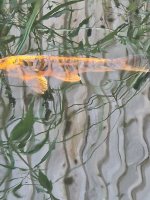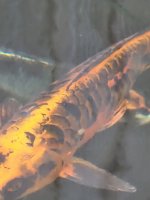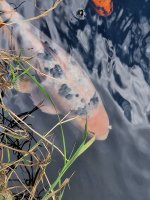- Joined
- Aug 17, 2023
- Messages
- 16
- Reaction score
- 16
- Country

New member here and would welcome some help from all the lovely knowledgeable people on here please.
We have a 12,000 litre sunken garden pond with approx. 20 fish, all koi aside from 2 shubunkin. It has a waterfall, skimmer box, pump and filter, UV lights etc (can get more specifics on these when husband is home) water is therefore well oxygenated and parameters are good. We use the NT labs water test kit so therefore no exact numbers but all nitrite, ammonia etc levels appear to be showing as all good. Never had any trouble with our pond, and have had happy healthy fish until recently. Thinking about investing in a better water testing kit which shows the numbers of each water parameter.
About 5 or 6 weeks ago we introduced 4 new koi to the pond without quarantining them. They came from a friends garden pond. Big mistake and very naive on our part. Since the new arrivals we have lost 3 koi, one of which we've had for 6 years and was about 12", this was devastating. At the time of introduction of the new fish, one koi hid in the rocks and unbeknown to us subsequently died and lay in the rocks for some time. Once we realised, we got him out, drained the entire pond, jet washed it all out, refilled with the hose and used aquasafe, putting all the fish back in once there was enough water in there.
Our remaining fish all seem to now have a problem with white patches on their bodies like a candle wax appearance (carp pox?) and are either hanging in the water or lying on the bottom with fins clamped to their bodies, lots of flashing going on, many are hiding in the cave or hanging near the bottom of the waterfall, none are gasping at the surface. They are not overly interested in feeding although if we leave them alone at feed time the food all gets eaten. Some of the lighter colour fish are also taking on a pinky coloured hue. Initially we thought this was white spot and we treated with acriflavine, 2 doses so far. I now think this is something else but don't have the knowledge or microscope etc to find out exactly what. Google is quite the minefield! I'm really worried that we will lose more fish and would really like some advice as we are at a loss, and have spent quite a bit of time and money trying to resolve the issues. Im now worried that we are treating for the wrong thing and therefore throwing chemicals into the water which aren't tackling the problem.
Can anyone advise on the best course of action? I have attached pictures of the white patches which we believe all the fish have to varying degrees.
Thankyou for reading my post.
We have a 12,000 litre sunken garden pond with approx. 20 fish, all koi aside from 2 shubunkin. It has a waterfall, skimmer box, pump and filter, UV lights etc (can get more specifics on these when husband is home) water is therefore well oxygenated and parameters are good. We use the NT labs water test kit so therefore no exact numbers but all nitrite, ammonia etc levels appear to be showing as all good. Never had any trouble with our pond, and have had happy healthy fish until recently. Thinking about investing in a better water testing kit which shows the numbers of each water parameter.
About 5 or 6 weeks ago we introduced 4 new koi to the pond without quarantining them. They came from a friends garden pond. Big mistake and very naive on our part. Since the new arrivals we have lost 3 koi, one of which we've had for 6 years and was about 12", this was devastating. At the time of introduction of the new fish, one koi hid in the rocks and unbeknown to us subsequently died and lay in the rocks for some time. Once we realised, we got him out, drained the entire pond, jet washed it all out, refilled with the hose and used aquasafe, putting all the fish back in once there was enough water in there.
Our remaining fish all seem to now have a problem with white patches on their bodies like a candle wax appearance (carp pox?) and are either hanging in the water or lying on the bottom with fins clamped to their bodies, lots of flashing going on, many are hiding in the cave or hanging near the bottom of the waterfall, none are gasping at the surface. They are not overly interested in feeding although if we leave them alone at feed time the food all gets eaten. Some of the lighter colour fish are also taking on a pinky coloured hue. Initially we thought this was white spot and we treated with acriflavine, 2 doses so far. I now think this is something else but don't have the knowledge or microscope etc to find out exactly what. Google is quite the minefield! I'm really worried that we will lose more fish and would really like some advice as we are at a loss, and have spent quite a bit of time and money trying to resolve the issues. Im now worried that we are treating for the wrong thing and therefore throwing chemicals into the water which aren't tackling the problem.
Can anyone advise on the best course of action? I have attached pictures of the white patches which we believe all the fish have to varying degrees.
Thankyou for reading my post.




